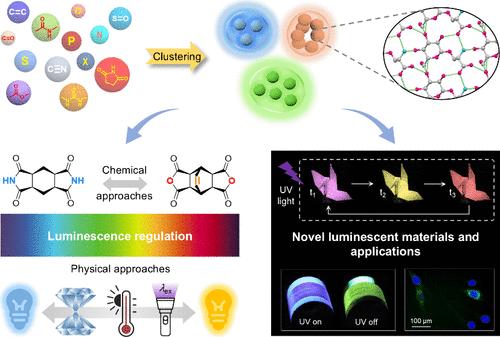当前位置:
X-MOL 学术
›
Acc. Chem. Res.
›
论文详情
Our official English website, www.x-mol.net, welcomes your
feedback! (Note: you will need to create a separate account there.)
Nonconventional Luminophores: Emission Mechanism, Regulation, and Applications
Accounts of Chemical Research ( IF 16.4 ) Pub Date : 2025-02-07 , DOI: 10.1021/acs.accounts.4c00794
Zihao Zhao 1 , Anze Li 1 , Wang Zhang Yuan 1
Accounts of Chemical Research ( IF 16.4 ) Pub Date : 2025-02-07 , DOI: 10.1021/acs.accounts.4c00794
Zihao Zhao 1 , Anze Li 1 , Wang Zhang Yuan 1
Affiliation

|
Nonconventional luminophores, characterized by the absence of extended (hetero)aromatic building blocks and alternating single–double/triple bonds, are composed primarily of electron-rich moieties, such as heteroatoms, double bonds, aliphatic amines, carbonyls, hydroxyls, cyano groups, amides, and their grouped functionalities. These unique structural features, coupled with their intriguing luminescent properties, have garnered significant interest for both fundamental research and promising applications, thus enabling widespread exploration. They generally benefit from abundant resources, simple synthesis, outstanding biocompatibility, and excellent photostability, empowering their potential applications in bioimaging, data storage and encryption, anticounterfeiting, bio- and chemosensing, etc. However, their research is preliminary, and the luminescence mechanisms remain elusive. For diverse systems, proposed conjectures, including tertiary amine oxidation, proton transfer, impurities, hydrogen bonding, and peptide bond electron delocalization, lack consistent correlation and universality, with some being subsequently invalidated. This lack of a unifying framework has hampered the development of effective guidelines for molecular design and photoluminescence (PL) regulation. To address these issues, a clustering-triggered emission (CTE) mechanism, focusing on the electron–molecule–aggregate multilevel structure–activity relationships, has been proposed. Specifically, it identifies the “clustered chromophores” of electron-rich moieties as emissive species. The CTE mechanism not only elucidates the emission behaviors of diverse nonconventional luminophores but also guides the PL regulation and further development of novel multifunctional luminescent materials.
中文翻译:

非常规发光团:发射机理、调节和应用
非常规发光团的特点是没有延伸的(杂)芳香族结构单元和交替的单-双/三键,主要由富含电子的部分组成,例如杂原子、双键、脂肪胺、羰基、羟基、氰基、酰胺及其分组官能团。这些独特的结构特征,加上它们迷人的发光特性,在基础研究和有前途的应用方面都引起了极大的兴趣,从而促进了广泛的探索。它们通常受益于丰富的资源、简单的合成、出色的生物相容性和出色的光稳定性,使其在生物成像、数据存储和加密、防伪、生物和化学传感等方面具有潜在应用潜力。然而,他们的研究是初步的,发光机制仍然难以捉摸。对于不同的系统,提出的猜想,包括叔胺氧化、质子转移、杂质、氢键和肽键电子离域,缺乏一致的相关性和普遍性,有些后来被否定。这种统一框架的缺乏阻碍了分子设计和光致发光 (PL) 调节的有效指南的制定。为了解决这些问题,人们提出了一种专注于电子-分子-聚集体多级结构-活性关系的聚类触发发射 (CTE) 机制。具体来说,它将富电子部分的“簇状发色团”确定为发射物质。CTE 机制不仅阐明了各种非常规发光团的发射行为,还指导了 PL 调控和新型多功能发光材料的进一步开发。
更新日期:2025-02-07
中文翻译:

非常规发光团:发射机理、调节和应用
非常规发光团的特点是没有延伸的(杂)芳香族结构单元和交替的单-双/三键,主要由富含电子的部分组成,例如杂原子、双键、脂肪胺、羰基、羟基、氰基、酰胺及其分组官能团。这些独特的结构特征,加上它们迷人的发光特性,在基础研究和有前途的应用方面都引起了极大的兴趣,从而促进了广泛的探索。它们通常受益于丰富的资源、简单的合成、出色的生物相容性和出色的光稳定性,使其在生物成像、数据存储和加密、防伪、生物和化学传感等方面具有潜在应用潜力。然而,他们的研究是初步的,发光机制仍然难以捉摸。对于不同的系统,提出的猜想,包括叔胺氧化、质子转移、杂质、氢键和肽键电子离域,缺乏一致的相关性和普遍性,有些后来被否定。这种统一框架的缺乏阻碍了分子设计和光致发光 (PL) 调节的有效指南的制定。为了解决这些问题,人们提出了一种专注于电子-分子-聚集体多级结构-活性关系的聚类触发发射 (CTE) 机制。具体来说,它将富电子部分的“簇状发色团”确定为发射物质。CTE 机制不仅阐明了各种非常规发光团的发射行为,还指导了 PL 调控和新型多功能发光材料的进一步开发。







































 京公网安备 11010802027423号
京公网安备 11010802027423号